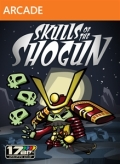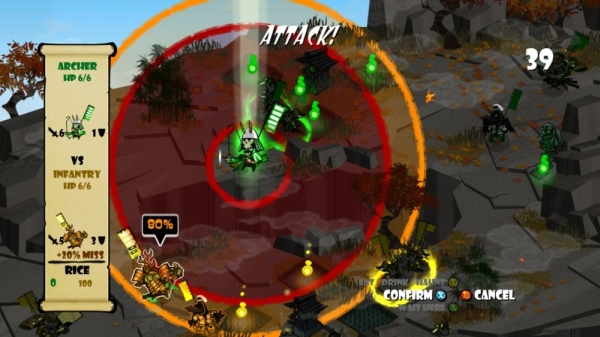
General Akamoto is having a pretty bad day. Just as he’s about to become Japan’s new Shogun, he’s betrayed by one of his own and killed. The icing on the cake? Someone is impersonating him. Skulls of the Shogun features fantastic art and sound design that marry themes from ancient Japanese art style with Cartoon Network style. The aesthetic attention to detail by 17-Bit is remarkable. The whimsical Japanese fantasy setting is brought to life by magnificent character and level design, and accessible, progressive tactical strategy gameplay.
Platforms: PC, Windows Phone, Xbox 360 (Version Played)
Publisher: Microsoft Studios
Developer: 17-Bit
Genre: Turn-Based Tactical Strategy
Release Date: January 30, 2013
ESRB Rating: Teen
 There are many distinctive units in the game, each with their own unique abilities. Infantry can move a short distance, but have the highest defense. Cavalry move the farthest, making them ideal for taking shrines or rice paddies straightaway. Archers have very little defense and can attack from range. The General is the linchpin. He is powerful, but let him die and you’ll be sent packing to the reload screen. Animal spirit monks are acquired via shrines. They provide support magic like healing, fireball spells, or the ability to blow units around the map with wind. All units can be upgraded by eating the skulls of defeated enemies. This takes the place of having to grind out experience to level up characters. This is a welcome change from the prototypical strategy game. The expertly-crafted levels are as important to the gameplay as the character design. Part of the strategy is how you use the elements of each stage to your advantage, such as pushing enemies off ledges, or avoiding evil Oni that randomly attack anyone near it.
There are many distinctive units in the game, each with their own unique abilities. Infantry can move a short distance, but have the highest defense. Cavalry move the farthest, making them ideal for taking shrines or rice paddies straightaway. Archers have very little defense and can attack from range. The General is the linchpin. He is powerful, but let him die and you’ll be sent packing to the reload screen. Animal spirit monks are acquired via shrines. They provide support magic like healing, fireball spells, or the ability to blow units around the map with wind. All units can be upgraded by eating the skulls of defeated enemies. This takes the place of having to grind out experience to level up characters. This is a welcome change from the prototypical strategy game. The expertly-crafted levels are as important to the gameplay as the character design. Part of the strategy is how you use the elements of each stage to your advantage, such as pushing enemies off ledges, or avoiding evil Oni that randomly attack anyone near it.
17-Bit actually manages to enhance the gameplay experience by minimizing some of the tedious elements that make strategy games a chore. Rejoice. There are no grids. Each round gives both sides five turns. It doesn’t matter how many units you may have on the board, you’ll only get five turns. I found it restrictive at first, but as I progressed, I realized how liberating it was. It speeds up the games while enhancing the difficulty by forcing you to make better use of your actions. Unfortunately, this means the campaign is a little on the short side, especially with an emphasis on leaderboards and speed runs. Your units can prevent being pushed or counterattacked by archers by bunching together and forming “spirit walls.” You can also tell if a unit will counterattack or not based on their stance.

Multiplayer brings some added replay value to the mix. Requisite Player and Ranked Deathmatches are included. It’s the “mode” that allows gamers across different platforms to create or join games that piqued my interest. You complete your turn and it is sent to your opponent who then gets a chance to do the same. Essentially it works out to the ancient idea of playing chess via mail: one turn at a time.
Skulls of the Shogun doesn’t take itself nearly as seriously as the likes of Tactics Ogre or Final Fantasy Tactics and that is its inherent beauty: a minimalist, comedic approach to a genre steeped in highfalutin’ convolution. Skulls of the Shogun plays on nostalgia with its 1970s-inspired grain-filtered cutscenes to loading screens with images that remind me of import games from the Sega Saturn/Sony PlayStation era. The campaign may run a bit on the short side, but that doesn’t take away from what a truly refreshing experience 17-Bit has put together. The stylish 2D art design, the feudal Japan theme, and the tight gameplay hit the sweet spot for me.

Review Disclosure: A review copy of Skulls of the Shogun was provided by Microsoft Studios for the purposes of this review.







